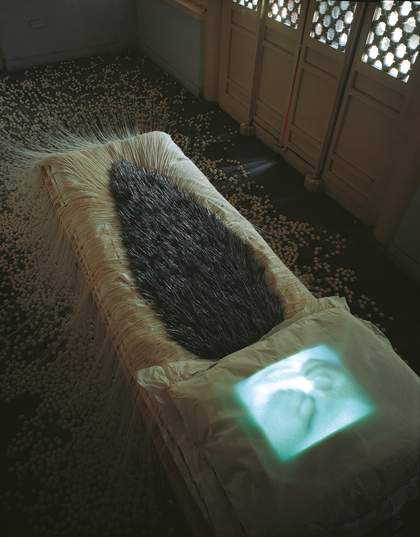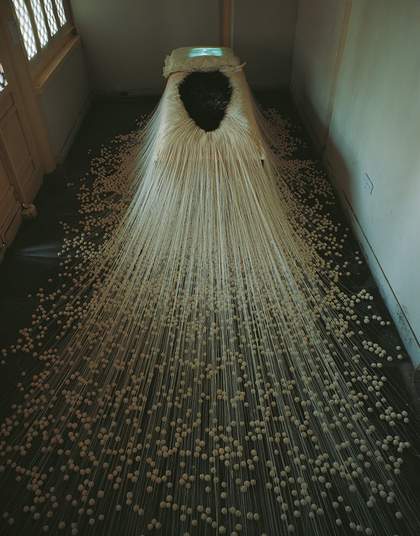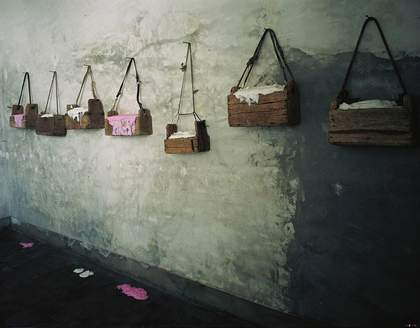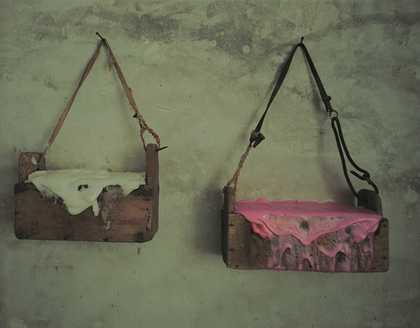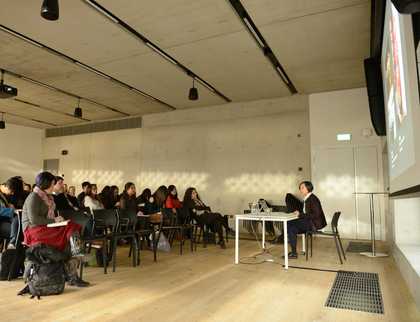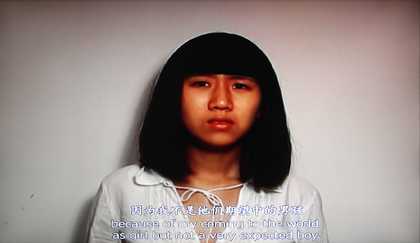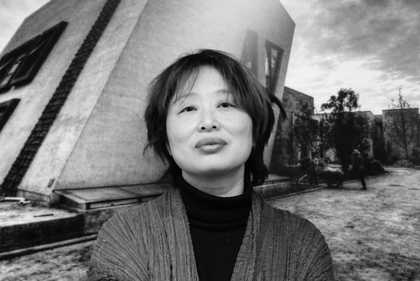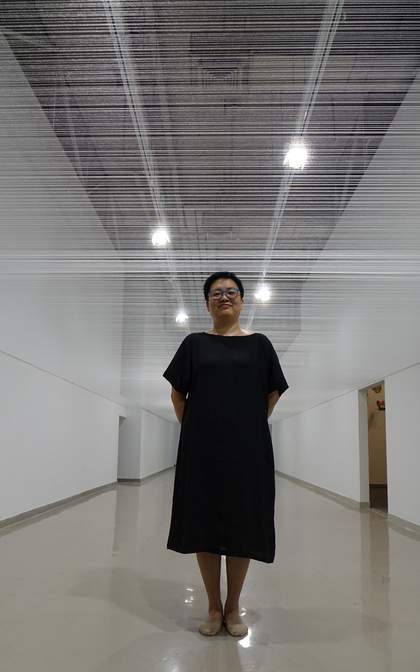
Lin Tianmiao
Image courtesy of the artist
Monica Merlin: When you came back to Beijing from New York in the early 1990s, China was going through a period of rapid economic development. Did you feel the changes?
Lin Tianmiao: I left in the 1980s before the ‘June Fourth Incident’, at a time when Beijing was closed to the rest of the world. The economy was very backward – there weren’t even supermarkets. But the people were pure. Everyone wanted to leave the country and go abroad, particularly the cultured classes. We left early, but not the earliest – there were some who left in the early 1980s. We left in the late 1980s. When my husband went to study abroad, I followed him as his spouse. The contemporary art circle in Beijing was very small – there were less than 100 people.
Monica Merlin: When you came back to Beijing, what did you want to do?
Lin Tianmiao: Before I left, I did not really know about the avant-garde. After six or seven years in America, it became very clear to me what I wanted to do. Back then in China, the government’s control was strict, and there were almost no spaces for exhibitions. If you organised an exhibition, you would get arrested. To find a way around this we created an ‘open studio’ with Wang Gongxin. It is a Western concept – opening an artist’s studio to the public at certain times. We did quite a lot of open studios during that time. Wang Gongxin did two or three exhibitions at his place, and I did one or two. Some friends did it too. Before each opening, we invited people by calling them up, and a circle of 200 people would turn up. But because it was quite dangerous, every event was very short: only two or three hours. Nevertheless, we were all idealistic and not commercial at all. We were doing it for ourselves. I think we were quite honest.
Monica Merlin: You made the work The Temptation of Saint Theresa during that period. The title is interesting. Is it related to Christianity? Could you discuss this work?
Lin Tianmiao: It was more about a state of mind than a reference to religion. I was trying to figure out how I could convey my ideas in an isolated space. At the time, only a few people could understand this piece. Things were not easy for an artist, and the title was a way for me to express my feelings. When I look back at the piece after many years and think about why I made it, I feel that I just did it, and it is not as complicated as you might imagine.
But I am interested in seemingly simple questions. The tools I used for this work are the ones construction workers use but they were filled with face cream. The two materials form a stark contrast, in terms of composition, gender-implication and function: there is a big distance between them. When I put them together, I think I created a rather eccentric effect. During the exhibition, the cream released a strong fragrance, filling up the entire space. The piece appeared to be very still, but it was actually full of power. The boxes were meant to contain the cream, and the cream was meant to be contained. But when they were hung on the walls, their relationship changed. The cream’s fragrance became stronger, and it took a more dominant position in your mind.
Monica Merlin: In the 1990s, particularly in 1995, there were many exhibitions showing the work of women artists and you were included in two of them. It seemed that the government was supportive of women artists at that time. Do you think so?
Lin Tianmiao: Actually that is not true. There were two figures that drove the scene. Liao Wen curated the first exhibition of women artists and she went on to do many more later. It was the first time I came across the idea of women’s art. Actually, Liao Wen’s purpose and the significance of that exhibition only became clear later, although the exhibition was important at the time nonetheless. The artists Liao Wen invited were ahead of their time, and they seem to be so even now. Nearly all the women artists working at the time, except a couple of them, were included in the exhibition. But ninety per cent of those artists do not make art any more. The other figure is Jia Fangzhou, whose perspective is very different from that of Liao Wen. Jia Fangzhou later curated many women artists’ exhibitions, but I think they did not evolve much.
Monica Merlin: The works you made in 1995 represent the first landmark moment in your career, such as The Proliferation of Thread Winding. Now that twenty years have passed, how do you feel about them when you look back?
Lin Tianmiao: I think those works were intuitive, brave, unpretentious and direct. There is a kind of power in them.
Monica Merlin: I read in other interviews that you started making art as a way to heal yourself and as a therapeutic process.
Lin Tianmiao: Yes, to release my emotions.
Monica Merlin: You also said that it was related to your mother and your family. Can you elaborate on the relationship between your mother and your art?
Lin Tianmiao: My mother was a cultured person. She used to be a dancer. When she could not dance any more, she became a researcher of dance. My father is a painter. So my family is artistic, and it was natural for me to become an artist. It was nothing surprising to me; there was no struggle. It was as though that was what I was meant to be.
When I look back at the materials I chose over the years and think about why I chose thread and other soft materials, I think it has to do with my personal experience. When I was a child, my mum sometimes asked me to help her with housework. It was actually like a form of corporal punishment in that it stamped a physical memory on me. When I came back from America and saw those kinds of materials again, I thought to myself: this is it, these are going to be my materials. It happened very naturally. Also, since I did a lot of housework when I was a child, it helped me acquire endurance and tenacity.
My father is highly regarded in traditional arts, so for me the pressure from my family was always great. I had to find my own means of self-expression. I purposely kept a distance from traditional arts. I deliberately deviated from their path in my creative approaches and ideas. I have often thought: can traditional arts really meet the need of self-expression in the contemporary world? I doubt it. I think that traditional Chinese arts reached their perfection several centuries ago when people had the right pace of life and state of mind. We cannot surpass them.
Monica Merlin: I found your work Boy and Girl from 2004 interesting as it speaks to the kind of hope and pressure that are imposed on us when we grow up, like being told how to behave and what to wear. Can you talk a bit more about this work?
Lin Tianmiao: Boy and Girl was made about ten years ago when my son was in his first year in primary school. I was reading a book, possibly written by a Swedish missionary. He documented many old Chinese nursery rhymes and children’s games, of which I only knew about thirty per cent. Most of them have been lost over time. Those rhymes and games can nurture a child, cultivate their team spirit and aesthetics, and teach them the rules of society. But later, when I was bringing up my child, I found that those thousands of years of traditions had disappeared. They had been replaced by a global culture. For example, every child plays with Lego now. Our educational system has been standardised, like a machine to produce boys and girls. It teaches boys to never cry and girls to be soft. It is socialised and regulated to fit into certain boxes. This is disrespectful not only to people’s individualities, but also to moral values and local cultures. This causes many problems in our society. I was thinking about this issue, but I did not have the courage to use my own child as an experiment to try to retain his ‘local’ quality. That was the backdrop for the work.
Monica Merlin: In an interview with Pi Li, you talked about the use of your own image and body. I found it fascinating. I remember you told Pi Li a story: when you were visiting a village, an old woman said your husband was lucky because you looked like you were capable of bearing children. You also said that you do not like using models in your art and prefer to use your own image and body. I find that in various cultures and countries, women are pressurised by the ideals they have to live up to and the way the media represents them. How do you see this in the context of your life and art?
Lin Tianmiao: That interview was done nearly ten years ago. My body has changed rapidly over the last ten years. I started using my body in my thirties and forties because of the changes that were happening to my body. The change of a body does not happen to just one person in one country, but to every human being. Everyone gets old and everyone’s body changes. There are so many stages of change, from a young girl to a woman in love, then to a mother, to a woman who has reached menopause, and so on. Our mind also experiences changes. The reason I used fat women was that they represent middle-aged women and the burdens they carry. I also did it as a protest against the established norms of beauty. My works are not drawn from the perspective of society or a man, but rather from women’s inward-looking eye. It is about how a woman looks at herself and her generation. I think the body’s changes are an important process – giving birth, putting on weight, marriage, psychological changes and so on. I experienced all of these, and I showed them in my works, which made it easier for me to cope with the process of reaching menopause.
Monica Merlin: Can you talk about the work Badges you started in 2009? It touches on the history of definitions of womanhood as well as chauvinism.
Lin Tianmiao: It is made of over 100 badges. The number grew to 300 or 400 later. We researched over 900 phrases and words but I did not make them all into badges.
Monica Merlin: Can you give an example of the badges and explain their significance?
Lin Tianmiao: I did not think of myself as a ‘woman artist’ and I did not care about that identity, but many interviewers like yourself have asked me about feminism. That prompted me to think about whether I am a feminist and about what I should say as a woman artist. My thinking was rational, not from a bodily dimension or intuition. I had a conversation with a critic, which touched me deeply. For a year after that, I felt lost. I wanted to find out how our society perceives women and how that perception has evolved. One thing I found is that the standards for women are created by men. Can we create our own criteria? Can I have my own criteria to define who I am? Once we have answered those questions, we can become free and open.
I researched dictionaries, including the Kangxi dictionary. In China, from ancient times to now, the number of words describing women in their professional capacities comes to around 200. Many professions have disappeared, and there are very few of them left. I also researched words from the internet that do not exist in dictionaries, such as internet slang, WeChat slang and words from popular novels and web fiction. I have found so many new phrases, and some of them are about women. With society shifting over the last 100 years, the scope of women’s careers has expanded dramatically. There are now many phrases describing different types of jobs and mental states of career women.
The influence came from Japan, other Asian countries and English-speaking countries. The phrases came into being in the urban pop-culture context. Every two weeks, or even every week, a new expression is being invented. My research team and I came across over 900 phrases. New phrases are invented particularly quickly in Japan. Why? I read three or four books about it. Why can’t they do it so quickly in Hong Kong? Hong Kong is like a village – it is not affected by external cultural influences, so new phrases describing gender develop slowly there. Singapore is similar. But Seoul, Shanghai and Beijing are like Kyoto: new phrases develop quickly.
From my research, I realised that women’s issues are diverse and complex. Women nowadays have been brave and confident to take up all those different roles. We made several variations of Badges. You have seen the first one. For the second one, we made the phrases into posters and put them on the walls in men’s public toilets with a phone number, similar to erotic advertisements in Japan. But the phone number is that of a gallery. The posters say, ‘If you are interested in me, come and find me.’ The posters were stuck on the walls of many men’s toilets around the city.
Monica Merlin: Did anyone call?
Lin Tianmiao: Yes, but I did not keep a record of who called. Another time, we hosted an event. I printed 800 badges which could be pinned on clothes. I piled them up at an opening, so that people could take them away as they liked. I found that no one picked the dirty words, but everyone wanted to take the good words. Later, my gallery in America asked if I could make half of the badges in Chinese, and the other half in English. That was challenging for me, because I did not know the accurate meanings of the English words, or whether they are adjectives or nouns. Recently, a Japanese gallery asked me to do a Japanese version. Japanese phrases are abundant. But in a way, working with Japanese phrases is even harder than English phrases, because they are so detailed and there are so many of them. We might work on that project in March [2014].
The words in this project are the ones that you cannot find in dictionaries. They are created quickly in spoken language and they disappear quickly too. But they touch on societal issues, have an effect on society and are very much alive. So I like this series very much. I think it helped solve many problems in my mind.
Monica Merlin: So you are going to Japan to work on this series in March?
Lin Tianmiao: Yes, March next year. It will be difficult, so I am going to collaborate with Japanese people. It was interesting that when I did it at the National Art Museum [in Beijing], they removed five or six political phrases. Also, some people did not understand certain words. For example, we had to explain what ‘three-high woman’ means. It was not easy to explain all those phrases, and I had a team made up of younger women who helped me explain every phrase clearly using just one sentence, which was a lot of work. For instance, the English phrase ‘gold digger’ is hard to translate into Chinese. We are still working on things like that.
Later, I had a solo exhibition of the All the Same series. Last year, I had a retrospective exhibition at the Asia Society in New York. This year, Galerie Lelong in Paris showed mainly my new work.
Monica Merlin: What are the works in Paris like?
Lin Tianmiao: My mother’s health was deteriorating when I worked on All the Same, and she passed away while I was still working on the project. During that time, my works suddenly became colourful, perhaps because I needed that. They represented an explosion of emotions, an emotional release. Those works meditated on death. I made works with themes like the relationship between human bones and a human being. From that solo exhibition, I moved away from caring about individuals or women to caring about the whole of society. At the time I had a strong feeling that I was about to embark on a journey. That piece of work took me over a year, and my emotions were released through the process of making it.
As for my work in Paris this year, I think that I actually needed to take a break and have some quiet time to calm down. But I do not think I had calmed down enough – I still felt strongly about social and political changes. So those works were about my strong feelings. Two or three works among them were my efforts to regain a peaceful mind, and to focus on artistic language and the human condition. That is where I am now.
Monica Merlin interviewed Lin Tianmiao in her studio-villa in Songzhuang, Beijing on 4 November 2013.
Published 21 February 2018

